And now for something a little different. The lines of good versus evil are blurred in Archvillain by Barry Lyga.
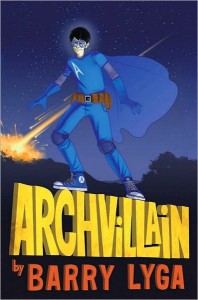 When a plasma storm hits the field behind Bouring Middle School, two things happen. The first: a mysterious kid soon known as Mighty Mike appears, imbued with amazing superpowers and the desire to perform heroic deeds with them, despite his amnesia and unfamiliarity with everyday customs. The second: Kyle Camden, local prankster, is gifted with his own set of abilities: strength, flight, and super-intelligence. Convinced that Mike’s an alien, Kyle tries to expose and discredit the new superhero with the aid of gadgets and trickery, only to meet defeat at every turn. Can the so-called Azure Avenger take down Mighty Mike? And hey, who’s the hero and who’s the villain here? Kyle, the hero of his own story, is becoming a villain in the eyes of the world, and it’s anyone’s guess what’ll happen next. This is the sort of comic book story that can only be told if you’re familiar enough with the tropes to invert and subvert them; luckily, Lyga’s clearly tapped into the right mindset. It’s a clever, twisted, thoughtful tale of ends justifying the means, and good versus evil. I’ll be interested to see where Lyga takes this in future installments, and how the relationship between hero and villain changes for the characters involved.
When a plasma storm hits the field behind Bouring Middle School, two things happen. The first: a mysterious kid soon known as Mighty Mike appears, imbued with amazing superpowers and the desire to perform heroic deeds with them, despite his amnesia and unfamiliarity with everyday customs. The second: Kyle Camden, local prankster, is gifted with his own set of abilities: strength, flight, and super-intelligence. Convinced that Mike’s an alien, Kyle tries to expose and discredit the new superhero with the aid of gadgets and trickery, only to meet defeat at every turn. Can the so-called Azure Avenger take down Mighty Mike? And hey, who’s the hero and who’s the villain here? Kyle, the hero of his own story, is becoming a villain in the eyes of the world, and it’s anyone’s guess what’ll happen next. This is the sort of comic book story that can only be told if you’re familiar enough with the tropes to invert and subvert them; luckily, Lyga’s clearly tapped into the right mindset. It’s a clever, twisted, thoughtful tale of ends justifying the means, and good versus evil. I’ll be interested to see where Lyga takes this in future installments, and how the relationship between hero and villain changes for the characters involved.
Remember what I said earlier about vampire princesses? Here’s another! Check out my review of Blood Feud by Alyxandra Harvey.
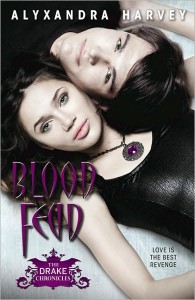 The vampire queen is dead, long live the new vampire queen. Helena Drake may be in charge following a brief, messy struggle, but the troubles aren’t over yet. The evil Lord Montmartre is still out there, and still eying the throne, and still determined to take it by kidnapping and wedding Helena’s daughter, Solange Drake. Luckily, the Drakes have Isabeau St. Croix, a resourceful young woman who survived the French Revolution before being transformed into a vampire and buried for centuries, on their side. Isabeau, now a fierce warrior known as a Hound, will do anything to protect her allies, especially if it means getting her revenge on the man who entombed her for two hundred years. With the dashing Logan Drake at her side, Isabeau must help foil the best-laid plans of Montmartre and his allies. And if Logan and Isabeau fall for one another along the way, well, no one’s about to object.
The vampire queen is dead, long live the new vampire queen. Helena Drake may be in charge following a brief, messy struggle, but the troubles aren’t over yet. The evil Lord Montmartre is still out there, and still eying the throne, and still determined to take it by kidnapping and wedding Helena’s daughter, Solange Drake. Luckily, the Drakes have Isabeau St. Croix, a resourceful young woman who survived the French Revolution before being transformed into a vampire and buried for centuries, on their side. Isabeau, now a fierce warrior known as a Hound, will do anything to protect her allies, especially if it means getting her revenge on the man who entombed her for two hundred years. With the dashing Logan Drake at her side, Isabeau must help foil the best-laid plans of Montmartre and his allies. And if Logan and Isabeau fall for one another along the way, well, no one’s about to object.
Alyxandra Harvey’s attention to detail, and ability to create complex, sympathetic characters, are what separate this book out from others of its ilk. In the small but growing field of “vampire princess books,” it’s characters like Isabeau and Logan, with their easy chemistry and genuine relationship, and supporting characters like Lucy (the token human and sassy stealer of scenes) who sell the story and make it shine. This is one series I always enjoy visiting.
Finishing out the second week of my big FebruarYAY! review bonanza, we have my coverage of Almost to Die For by Tate Hallaway. Who knew the “vampire princess” subgenre was growing in popularity?
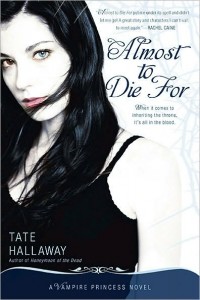 Anastasija Parker always figured she was just a late-blooming True Witch, and she’d come into her powers eventually. Unfortunately, when she turns sixteen and she’s still as boring as ever, she figures that’s it. No powers, no coven, no dice. And then her long-lost father turns up, and drops a bombshell: Ana is half-vampire, half-witch, the product of an ill-advised tryst all those years ago, and it’s time for her to claim her status as vampire princess. Now she’s caught between two worlds, with both parents trying to influence her choice, attracted to two different guys, and oh yes, a renegade faction of vampires determined to kill her. The casually irreverent narrative voice makes it easy to underestimate this story of a teen caught in the ultimate parental dispute, and the main character isn’t the most sympathetic, but it’s an interesting story nonetheless. Part romance, part drama, fleshed out with interesting supporting characters (my favorite: Taylor, the geeky Somali who totally rocks the colorful hijabs), it’s a nice start to a new series.
Anastasija Parker always figured she was just a late-blooming True Witch, and she’d come into her powers eventually. Unfortunately, when she turns sixteen and she’s still as boring as ever, she figures that’s it. No powers, no coven, no dice. And then her long-lost father turns up, and drops a bombshell: Ana is half-vampire, half-witch, the product of an ill-advised tryst all those years ago, and it’s time for her to claim her status as vampire princess. Now she’s caught between two worlds, with both parents trying to influence her choice, attracted to two different guys, and oh yes, a renegade faction of vampires determined to kill her. The casually irreverent narrative voice makes it easy to underestimate this story of a teen caught in the ultimate parental dispute, and the main character isn’t the most sympathetic, but it’s an interesting story nonetheless. Part romance, part drama, fleshed out with interesting supporting characters (my favorite: Taylor, the geeky Somali who totally rocks the colorful hijabs), it’s a nice start to a new series.
And today’s offering is Ivy’s Ever After by Dawn Lairamore. Dragons, princesses, clever twists, what’s not to like?
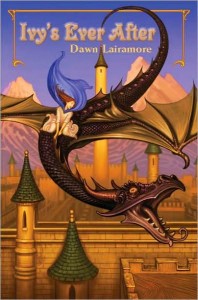 For many years, it’s been the custom for the princesses of Ardendale to be locked up in a tower on their fourteenth birthday, guarded by a dragon. Whoever kills the dragon gets to marry the princess and become the next king. Strange as it seems, this Dragon Treaty has kept peace between humans and dragons for generations. However, when the time comes for untraditionally-minded Princess Ivy to take up residence in the tower, she actually runs away … with her dragon guardian acting as companion on her quest to track down her long-missing fairy godmother. It’s the only way to foil the evil plans of the wicked Prince Romil of Glacia, as well as the only way for Ivy to determine her own fate and prevent her new dragon friend from a horrible death. All they have to do now is survive a trip filled with giant spiders, hungry trolls, haunted swamps, and cranky dragons.
For many years, it’s been the custom for the princesses of Ardendale to be locked up in a tower on their fourteenth birthday, guarded by a dragon. Whoever kills the dragon gets to marry the princess and become the next king. Strange as it seems, this Dragon Treaty has kept peace between humans and dragons for generations. However, when the time comes for untraditionally-minded Princess Ivy to take up residence in the tower, she actually runs away … with her dragon guardian acting as companion on her quest to track down her long-missing fairy godmother. It’s the only way to foil the evil plans of the wicked Prince Romil of Glacia, as well as the only way for Ivy to determine her own fate and prevent her new dragon friend from a horrible death. All they have to do now is survive a trip filled with giant spiders, hungry trolls, haunted swamps, and cranky dragons.
This story of a girl and her dragon is sure to remind some readers of other stories told along the same lines, from Patricia Wrede’s Enchanted Forest Chronicles to Jessica Day George’s Dragon Slippers, but it’s still a rather charming, fast-paced, enjoyable story in its own right. It’s easy to cheer for a princess who takes control of her own destiny, a decidedly nonstandard dragon, and all the other subtly twisted fairy tale trappings in attendance here, and it makes for a fun read.
Today’s offering is Geektastic, edited by Holly Black and Cecil Castellucci. This is a book that’s near and dear to my own geeky heart, and when I develop a time machine, I’m sending a copy back to my teenage self. Excellent lineup of YA authors, and a whole lot of fun.
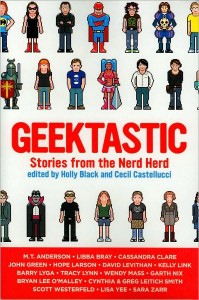 My name is Michael, and, to no one’s surprise, I am a geek. While the manner in which I express my geekitude has changed over the years, from theatre, to writing, to gaming, I’ve always embraced my geekdom. And so I have to say, this is the book I wish I’d had in high school. I really, really wish this anthology had existed back then. Because this book is full of pure whimsical awesomeness, and is a celebration of all things geek. Black and Castellucci have assembled an all-star cast, and encouraged each and every one of them to let their passions and their freak flags fly proudly.
My name is Michael, and, to no one’s surprise, I am a geek. While the manner in which I express my geekitude has changed over the years, from theatre, to writing, to gaming, I’ve always embraced my geekdom. And so I have to say, this is the book I wish I’d had in high school. I really, really wish this anthology had existed back then. Because this book is full of pure whimsical awesomeness, and is a celebration of all things geek. Black and Castellucci have assembled an all-star cast, and encouraged each and every one of them to let their passions and their freak flags fly proudly.
While it’s easy to point at almost any story here and say it’s an excellent piece of work, there are a few which really stand out. First and foremost is Black and Castellucci’s own “Once You’re A Jedi, You’re A Jedi All The Way,” in which a Klingon and a Jedi meet at a convention, have a little too much to drink, and well … the Jets and the Sharks have nothing on Trekkies and Star Wars fans. Can a cross-universe affair work out, or will someone go to the Dark Side? I love the characters, and the situation is both absurd and believable.
Tracy Lynn’s “One Of Us,” about a cheerleader who pays the AV Club to teach her to speak geek in order to impress a guy, is somewhat more predictable in how it turns out, but it’s the good kind of predictable, where you totally root for the characters anyway, and want to see a happy ending. (Hmmm, seems to me this would make a great movie.) It’s a story that really speaks to the importance of owning your passion, whether it’s science fiction, fantasy, or classic romance flicks.
Cassandra Clare’s “I Never” explores the potential for trouble that arises when members of an online roleplaying community meet up in real life … and not everyone lives up to their electronic persona.
Devid Levithan’s “Quiz Bowl Antichrist” shows that just because you’re smart doesn’t mean you have all the answers, while some situations don’t have any answers at all.
Lisa Yee demonstrates that geekery comes in every form, such as baton twirling, in “Everyone But You.” I guess it shows my own geek bias that until now, I’d have sniffed at baton twirling, but here, we see that it’s all a matter of perspective.
Sadly, one story which stands out, does so not because it’s good, but because it’s kind of disturbing. Barry Lyga (an author I love to read, by the way), turns in a strange tale of revenge in “The Truth About Dino Girl.” It’s a cautionary tale: don’t mess with the geeks or bully the outcasts, because you never know when one of them will snap and find a way to ruin your life, but it’s still a fairly ugly piece when you think about actions and consequences. Compared to the other stories, it’s a disharmonious note.
Back to something a bit more reassuring, Wendy Mass’ “The Stars At The Finish Line” is a quirky tale of competition, romance, and astronomy. Here’s another story with sympathetic, believable characters, great chemistry, and a feel-good ending.
Naturally, no collection of geekery would be complete without a Rocky Horror story, and Libba Bray’s “It’s Just A Jump To The Left” satisfies that need, and more.
Scattered between the stories are a number of comic strips, further exploring various aspects of geekdom, written by Black and Castellucci, and alternately drawn by Hope Larson and Bryan Lee O’Malley. These add just that much more flavor to the overall excellent feel of the anthology, and make it truly worth the price of admission. Whether you’re into art, cheerleading, science, theater, science fiction, fantasy, or trivia contests, the message remains the same: embrace that which makes you happy and interesting, stand tall in the face of those who’d mock you, and have fun.
Man, I really could have used this book back then, but I’m damned glad it exists now.
